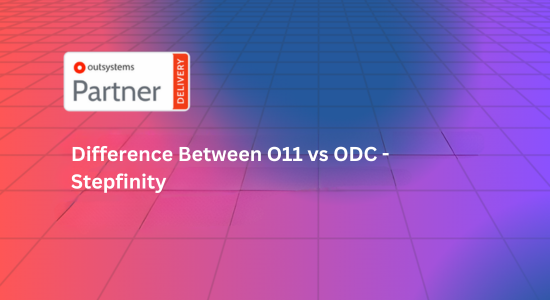The rapid evolution of technology has fundamentally changed how businesses operate, and low-code development platforms like OutSystems are at the forefront of this transformation. As a leading OutSystems partner, Stepfinity offers valuable insights into the future of low-code development. This blog explores emerging trends, benefits, and the transformative impact of low-code platforms on the digital landscape.
Emerging Trends in Low-Code Development
AI and Machine Learning Integration
Artificial intelligence (AI) and machine learning (ML) are becoming integral to low-code development. Stepfinity predicts that:
- Enhanced Automation: AI-driven automation will streamline development processes, reducing the need for manual coding and speeding up application delivery.
- Intelligent Recommendations: ML algorithms will provide intelligent recommendations for code optimization, bug fixes, and feature enhancements.
Hyperautomation
Hyperautomation involves the use of advanced technologies to automate complex business processes. In the context of low-code development, this trend includes:
- End-to-End Process Automation: Combining low-code platforms with AI, robotic process automation (RPA), and other technologies to automate entire business workflows.
- Scalability and Flexibility: Enabling businesses to scale their automation efforts rapidly and adapt to changing requirements.
Citizen Development
Citizen development empowers non-technical users to create applications using low-code platforms. Stepfinity anticipates:
- Increased Adoption: More organizations will adopt citizen development to reduce the burden on IT departments and accelerate digital initiatives.
- Training and Governance: Providing training and establishing governance frameworks to ensure that citizen developers create secure, compliant, and high-quality applications.
Cross-Platform Development
The demand for applications that work seamlessly across multiple platforms is growing. Low-code platforms are evolving to support:
- Unified Development Environments: Enabling developers to create applications that run on web, mobile, and desktop platforms using a single codebase.
- Responsive Design: Ensuring that applications deliver a consistent user experience across different devices and screen sizes.
Focus on Security and Compliance
As low-code platforms become more prevalent, ensuring security and compliance is crucial. Key trends include:
- Built-In Security Features: Low-code platforms will increasingly offer built-in security features, such as encryption, authentication, and access control.
- Compliance Automation: Automating compliance checks and reporting to meet regulatory requirements more efficiently.
Benefits of Low-Code Development
Accelerated Time-to-Market
Low-code development significantly reduces the time required to build and deploy applications. Benefits include:
- Rapid Prototyping: Quickly creating prototypes to validate ideas and gather feedback.
- Faster Iterations: Enabling faster iterations and continuous improvement based on user feedback and changing requirements.
Cost Efficiency
Low-code platforms can reduce development costs by minimizing the need for extensive coding and reducing reliance on specialized developers. This results in:
- Lower Development Costs: Reduced need for large development teams and extensive coding efforts.
- Maintenance Savings: Easier maintenance and updates due to the visual nature of low-code platforms.
Increased Agility
Low-code development enhances organizational agility by allowing businesses to respond quickly to market changes and new opportunities. This includes:
- Adaptability: Quickly adapting applications to meet new business requirements.
- Innovation: Fostering innovation by enabling rapid experimentation and deployment of new ideas.
Improved Collaboration
Low-code platforms facilitate collaboration between IT and business teams, leading to better alignment and more effective solutions. Benefits include:
- Unified Teams: Bridging the gap between technical and non-technical stakeholders.
- Streamlined Workflows: Simplifying workflows and improving communication through visual development tools.
Enhanced Customer Experience
Low-code platforms enable businesses to create user-friendly applications that enhance the customer experience. This involves:
- Intuitive Interfaces: Designing intuitive and responsive user interfaces.
- Personalization: Delivering personalized experiences based on user data and preferences.
Transformative Impact of Low-Code Platforms
Digital Transformation
Low-code platforms are driving digital transformation by enabling businesses to modernize legacy systems, automate processes, and innovate faster. Key aspects include:
- Legacy System Modernization: Replacing outdated systems with modern, low-code applications that offer improved functionality and user experience.
- Process Automation: Automating repetitive tasks and complex workflows to enhance efficiency and productivity.
- Innovation Enablement: Facilitating innovation by reducing the time and cost associated with developing new applications.
Empowering Business Users
Low-code development empowers business users to take an active role in application development, leading to:
- Democratized Development: Allowing business users to create applications without relying solely on IT departments.
- Faster Problem-Solving: Enabling business users to quickly address and solve problems with tailored applications.
Competitive Advantage
Organizations that leverage low-code platforms gain a competitive advantage by being more agile, innovative, and responsive to market demands. This includes:
- Market Responsiveness: Quickly adapting to changing market conditions and customer needs.
- Innovation Leadership: Leading the way in innovation by rapidly deploying new solutions and services.
Stepfinity’s Role in Shaping the Future
Expertise and Innovation
As a leading OutSystems partner, Stepfinity is at the forefront of low-code development innovation. They bring:
- Technical Expertise: Deep knowledge of the OutSystems platform and best practices for low-code development.
- Innovative Solutions: Delivering innovative solutions that address unique business challenges and drive digital transformation.
Client-Centric Approach
Stepfinity’s client-centric approach ensures that each solution is tailored to meet specific business needs. This includes:
- Customized Solutions: Designing solutions that align with the client’s strategic goals and objectives.
- Ongoing Support: Providing continuous support and updates to ensure long-term success.
Thought Leadership
Stepfinity is committed to thought leadership in low-code development, sharing insights and best practices to help businesses navigate the evolving digital landscape. This involves:
- Industry Insights: Offering insights into emerging trends and technologies.
- Best Practices: Sharing best practices for successful low-code development and implementation.
Conclusion
The future of low-code development is bright, with emerging trends like AI integration, hyperautomation, citizen development, and a focus on security and compliance driving the evolution of the industry. Stepfinity, as a leading OutSystems partner, is well-positioned to help businesses harness the power of low-code platforms to achieve their digital transformation goals. By leveraging Stepfinity’s expertise, innovative solutions, and client-centric approach, organizations can navigate the future of low-code development with confidence and success.








